Oregon Boating Safety Requirements
Life Jackets (aka Personal Flotation Devices (PFDs)
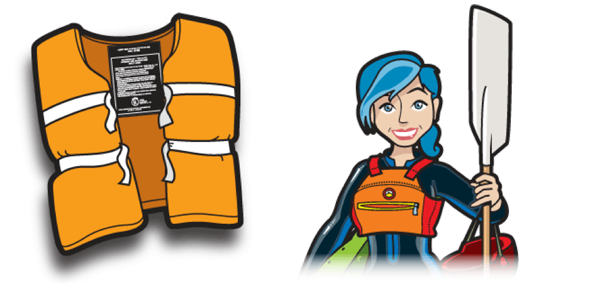
- The Oregon State Marine Board (OSMB) requires at least one throwable U.S. Coast Guard approved Type IV device (ring buoy OR cushion) on a boat 16 feet or more in length, in ADDITION to a properly fitting, wearable US Coast Guard approved life jacket required for each person onboard all boats.
- Manually propelled canoes and kayaks 16 ft in length and over are exempted from carrying the additional throwable Type IV device.
- Someone being towed behind a boat is considered to be onboard.
- PWC operator and passengers must be wearing their life jackets while underway.
- Inflatable life jackets are not approved to use during high impact sports such as water skiing or operating a PWC.
- Inflatable life jackets are not authorized for use by children under the age of 16. However, some hybrid inflatables have been approved for children.
Children
All children 12 years of age and younger on an open deck or open cockpit, must be wearing their PFD while the vessel is underway or while being towed.
Class III Rapids
All persons operating a boat as well as all passengers in the boat is required to wear an approved and properly fitted U.S. Coast Guard wearable life jacket on all Class III rapids and higher.
Alcohol & Boating Under the Influence (BUI)
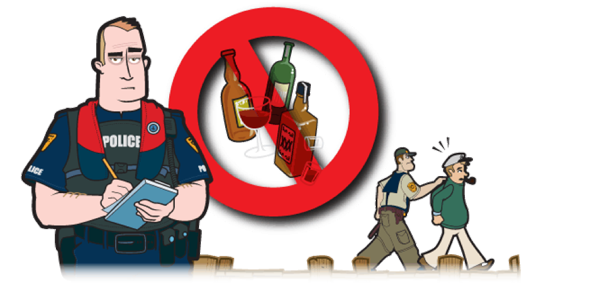
A boater with a blood alcohol content (BAC) of .08% or more is considered to be under the influence. However, a boat operator showing any sign of impairment due to alcohol or drugs is subject to arrest. BUI is a class A misdemeanor punishable by up to one year in prison and a maximum fine of $6,250. If the boater is found guilty of BUI, they will be required to complete a safe boating class, are not allowed to operate a boat for 1 year, and will have all boat registrations in their name suspended for 3 years.
Any person operating a boat on any Oregon waters have given consent to submit to breath and field sobriety tests.
Oregon Boat Registration

All vessels propelled by machinery, including gasoline, diesel and electric motors, and principally operated on Oregon waters must be titled and registered by the OSMB. U.S. Coast Guard documented vessels must also be registered with the Marine Board if classified as a recreational vessel.
Exemptions to the boat registration requirements include:
- Sailboats that are under 12 feet long;
- U.S. Coast Guard documented vessels that are principally used in another state;
- Vessels that are properly registered in another state and that are operating on Oregon waters for no more than 60 consecutive days.
Certificate of Number
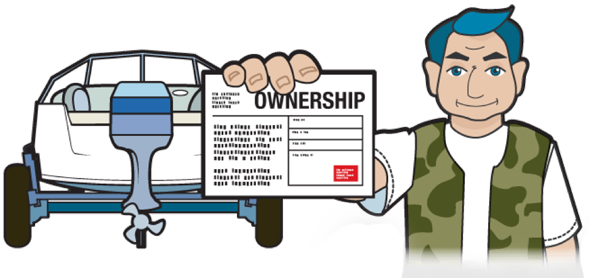
Boat owners must have at least a temporary permit before they can operate in Oregon waters. Upon receipt of the Certificate of Number please note the following:
- It must be carried onboard when operating the vessel.
- It is valid for two calendar years and expires on December 31st of the second year.
- The OSMB must be notified within 30 days if the boater changes residences.
The Certificate of Number, validation decals and title are obtained by application to an authorized boat registration agent or to:
Oregon State Marine Board
P.O. Box 14145
Salem, OR 97209-5065
Cost to Register a Boat in Oregon
Boat numbers must:
- Be affixed on both sides of the bow;
- Be block letters, three inches high and contrasting with the color of your boat;
- Letters must be separated from the numbers by a space or a hyphen.
- This is a federal and state requirement.
- The decal which is provided to you by the OSMB should be displayed on both sides of the boat.
Lack of the correct documentation may result in delays and fines.
Agency Fees - www.oregon.gov/osmb/Pages/boat-Fees.aspx
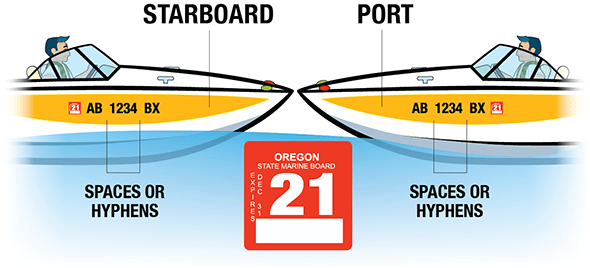
Make sure all boats are properly marked and documented. It is a requirement to carry your Certificate of Number on your boat.
Invasive Species
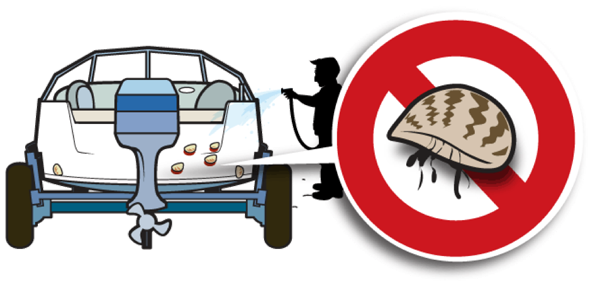
Non-native aquatic species (plants, fish and animals) are found within Oregon's waters. These pests can increase dramatically under the right conditions, displacing native species, clogging waterways, and impacting navigation and recreation. Once introduced, they are nearly impossible to eliminate. Zebra and Quagga Mussels are nuisance species that can be accidentally transported by recreational boaters when attached to propellers, intake systems and hulls.
You can help prevent the introduction and spread of non-native species from
one body of water to another. Once on shore, away from the water:
- Inspect your boat and remove aquatic plants or animals before you leave any body of water.
- Flush raw-water cooling systems and clean sea strainers before moving your boat from one body of water to another.
- Empty bait buckets and remove any plant fragments from bait wells, fishing gear, trailers, dive gear or props. Dispose of the plant fragments on land, in a garbage receptacle.
- Drain water from your motor, live wells and bilge.
- Wash your boat before putting it into a new body of water.
- Report sightings of non-native species to 1-866-INVADER or call 1-800-437-2744, 24 hours 7 days a week.
Aquatic Invasive Species Prevention Permit
Motor and Sail Boaters:
Oregon motorboat and sailboat operators will be charged a $5 surcharge to their boat registration fee. Current registration decals act as proof of payment and are valid for two calendar years.
Out-of-state operators of powerboats and sailboats must purchase an annual $22 ($20 permit + $2 agent fee) AIS prevention permit, available at Oregon Department of Fish and Wildlife license agents or go online to apps3.oregon.gov to purchase your permit.
Waterway Access Permit: Non-motorized boaters
Oregon residents and out-of-state operators of non-motorized boats, i.e., canoes, kayaks, stand-up paddleboards, rafts, drift boats and other manually powered boats, which are 10 feet in length or longer must carry a Waterway Access Permit when paddling on Oregon waters. You will need to purchase:
- a one week ($5), or
- a one year ($17), or
- a two-year ($30) permit when operating on Oregon waters.
One permit is required per boat; the permit is transferable from boat to boat, and not required for youth 13 and younger.
Go to the OSMB website for more information on where to purchase the permits.
ATTENTION: out-of-state operators of all types of boats, PLEASE clean your boats before entering Oregon waters, especially if you come from a state that is infested with Zebra and Quagga mussels.
Personal Watercraft Laws & Regulations
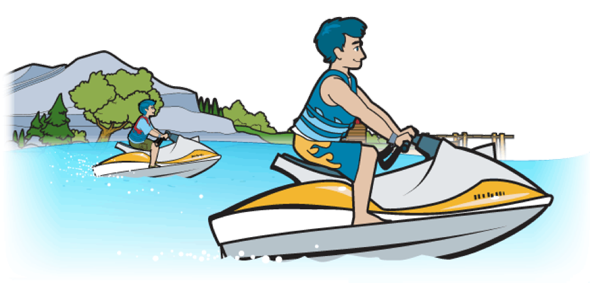
Do not underestimate PWCs - they are very powerful for their small size and demand the same respect as any boat. In fact, PWC operation must adhere to the same rules and regulations as any other powerboat - including registration with the state and a B-1 class fire extinguisher aboard.
PWCs have some additional requirements:
- The operator as well as all passengers on a PWC must be wearing an inherently buoyant U.S. Coast Guard approved Type I, II, or III PFD.
- When towing someone on a tube or on water skis, there must be capacity on the PWC to accommodate the operator, the observer as well as the tuber/skier(s).
- PWCs must stay at a distance of 200ft from other water skiers or others being towed behind a vessel.
- PWCs must operate at slow 'no-wake' speed, maximum 5 mph limit when:
- Within 200ft of a swimmer, surfer, diving flag, bank or wading angler, dock, swim float, boat launch, ramp, pier, marina, floating home, moorage area, or boathouse;
- Within 100ft of any vessel that is anchored or un-powered; or
- Within 200ft of shoreline on all lakes, reservoirs, and bays.
- PWC operators in Oregon must not exceed 10mph when approaching within 100ft of a motorized or sailing vessel that is underway.
Hours of Operation
PWCs may be operated at all hours of the day, but must be fitted with the required lights in order to operate legally between sunset and sunrise.